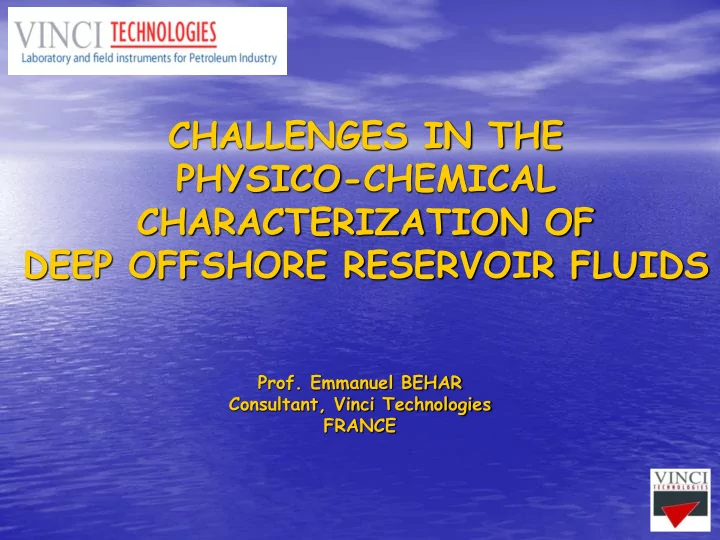

CHALLENGES IN THE PHYSICO-CHEMICAL CHARACTERIZATION OF DEEP OFFSHORE RESERVOIR FLUIDS Prof. Emmanuel BEHAR Consultant, Vinci Technologies FRANCE
Deep offshore reservoir fluids present physico-chemical characteristics which are rarely met with conventional crude oils and natural gases. emmanuel.behar@orange.fr 2
Such specific properties and behaviour are due to the coexistence of 3 important operational parameters: high reservoir pressures which can reach 150 MPa (1500 bars); high temperatures which can go up to 500 K (230 ° C); a bi-modal distribution of hydrocarbons with the coexistence of methane with high molecular weight components, which can be waxes or naphthenes or asphaltenes. emmanuel.behar@orange.fr 3
The first 2 of these parameters has lead to call these fluids as hyperbaric (High Pressure-High Temperature) fluids. The last one leads to unwanted plugging problems which can occur either in the production wells, or in the risers as well as in the flow-lines which connect subsea wellheads to a nearby platform (and/or to onshore) treatment facilities. emmanuel.behar@orange.fr 4
emmanuel.behar@orange.fr 5
DRY RY GAS S HYDRATES DRATES RGBE09-04AH115 - Natural Gas emmanuel.behar@orange.fr 6
LEAN AN CO COND NDENS ENSATE ATE GAS HYDRA DRATES TES emmanuel.behar@orange.fr 7
P-T T PHASE ASE DIAGRAM GRAM OF A DEEP P OFFSHO SHORE RE « WAXY XY » NATU TURA RAL L GAS 800 Experimental S 700 Modeled critical point + L 600 500 400 L G 300 L + G L + G 200 + S 100 0 0 25 50 75 100 125 150 175 200 Temperature ( ° C) emmanuel.behar@orange.fr 8
HIGH GH MW SATU TURA RATES TES DISTR TRIBUTION IBUTION IN PRODUCED DUCED OIL & ITS AS ASSOCIAT CIATED ED DEPOSIT OSIT FOR FIELD LD P emmanuel.behar@orange.fr 9
*A *A MIX IXTURE TURE OF CR CRYSTAL STALS S & & GELS* LS* • HYD YDRAT ATES ES FORMED D DURING ING THE TRANS ANSPO PORT RT IN A A SEA-LINE LINE OF • AN AN AS ASPHALTE HALTENIC NIC CRUDE E • !!! emmanuel.behar@orange.fr 10
These illustrations of such sophisticated phase diagrams involving solids deposition strongly emphasize the necessity to propose the following solutions at the first steps of fields development: Firstly, to use tailor-made characterization equipment for HP-HT reservoir fluids: emmanuel.behar@orange.fr 11
HYDROCARBONS COMPOSITION ANALYSER Following the flash of the live fluid sample to ambient conditions, compositional analysis of residual hydrocarbon liquid and evolved gas phase is conducted using gas chromatography (GC). Two standard Gas Chromatographs are used to analyse the composition of the gaseous and liquid fractions of the sample. The values obtained from the two GC are used to generate compositional PVT reports of the sample including separator gas, separator liquid and recombined sample emmanuel.behar@orange.fr 12
FLUID EVAL LNG version The system allows to study the phase behaviour of natural gas at conditions of high pressure and ultra low temperature. It is used to simulate the liquefaction of HC gas during a freezing process. emmanuel.behar@orange.fr 13
HYDREVAL & KINETIC EVAL The kinetic-Eval analyser is used for studying the kinetics of gas hydrates formation by measuring the induction time for the formation of crystals and measuring their growth rate after nuclei are formed. It is also used for determining the hydrates composition and evaluating kinetic hydrate inhibitors and other inhibitors such as anti agglomerant, dispersants, natural inhibitors such as salts. The instrument provides four different methods to study hydrates phenomena : (a) isochoric method (constant volume), isobaric method (constant pressure) , isothermal method (constant temperature) and visual method. emmanuel.behar@orange.fr 14
FLASS The Flass analyzer allows for complete oil PVT studies and a variety of asphaltenes and wax solid deposition experiments, such as bulk filtration tests, particle size distribution and solids onset determinations. It also includes a Solid Detection System used to detect when the organic deposition takes place. A High Pressure Microscope permits to visualise accurately the Wax and Asphaltenes precipitation at onset conditions, identify the solid particles and monitor the change in size and morphology of Wax crystals and Asphaltenes solids as a function of temperature, pressure, time and the effect of various chemical treatments. The amount of solids formed in the fluid sample when altering the pressure, temperature or composition of the fluid can also be determined using the HP-HT organic solid filtration system. emmanuel.behar@orange.fr 15
Next, to create adapted experimental procedures which lead to accurate, reliable and consistent data for these “non - conventional” fluids Finally, to integrate adapted compositional models, both in reservoir and in process engineering simulators, in order to optimize the design as well as the operating conditions of production and treatment facilities emmanuel.behar@orange.fr 16
Future Vision : Integrated Deep Offshore Fields Development emmanuel.behar@orange.fr 17
THANK YOU FOR YOUR ATTENTION emmanuel.behar@orange.fr 18
Recommend
More recommend